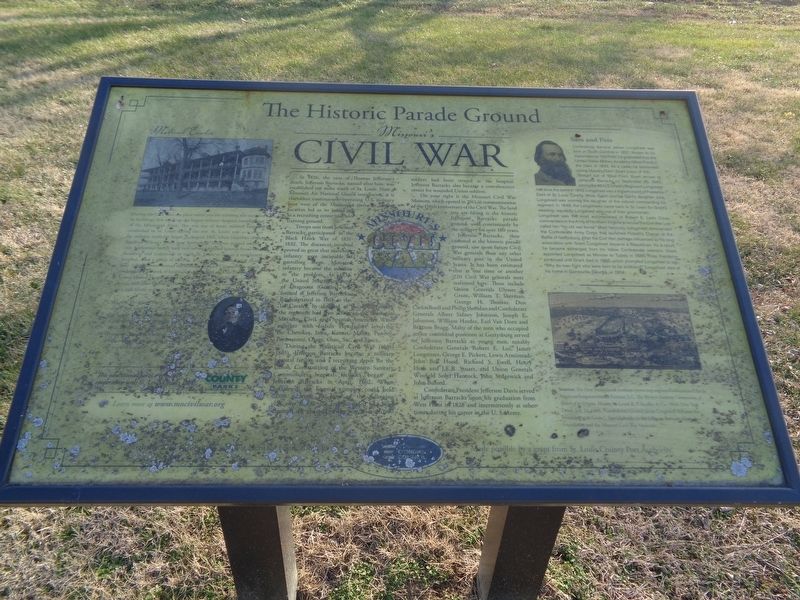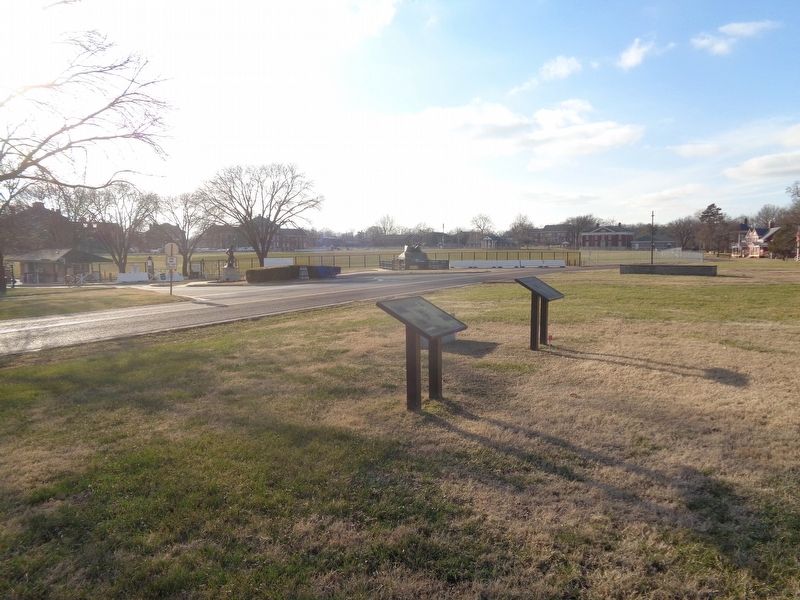Lemay in St. Louis County, Missouri — The American Midwest (Upper Plains)
The Historic Parade Ground
Missouri's Civil War
Troops sent from Jefferson Barracks participated in the Black Hawk War of 1831-1832. The distances involved proved so great that marching infantry were incapable of patrolling them. Mounted infantry were incapable of patrolling them. Mounted infantry became the solution to the problem. In 1833, the United States Regiment of Dragoons (Cavalry) was formed at Jefferson Barracks Re-designated in 1861 as the 1st Cavalry, by the end of the 19th century the regiment had seen action in the Seminole, Mexican, Civil and Spanish-American Wars, together with Indian expeditions involving the Cherokee, Iowa, Kansas, Mahas, Pawnee, Potawatomi, Osage, Otoe, Sac, and Sioux.
During the American Civil War (1861-1865), Jefferson Barracks became a military hospital facility and a recruiting depot for the Union. Construction of the Western Sanitary Commission's hospital facilities began at Jefferson Barracks in April, 1862. When completed, the hospital complex could hold (unreadable) patients. By June of the following year, over (unreadable) sick and wounded had been admitted. By the end of the war, over 26,000 soldiers had been treated at the hospital. Jefferson Barracks also became a convalescence center for wounded Union soldiers.
On your right is the Missouri Civil War Museum, which opened in 2011 in commemoration of the 150th anniversary of the Civil War. The land you are facing is the historic Jefferson Barracks parade ground, used continuously by the military for over 180 years.
Jefferson Barracks, then centered at the historic parade ground, saw more future Civil War generals than any other military post in the United States. It has been estimated that at one time or another 220 Civil War generals were stationed here. These include Union Generals Ulysses S. Grant, William T. Sherman, George H. Thomas, Don Carlos Buell and Philip Sheridan and Confederate Generals Albert Sidney Johnston, Joseph E. Johnston, William Hardee, Earl Van Dorn and Braxton Bragg. Many of the men who occupied senior command positions at Gettysburg served at Jefferson Barracks as young men, notably Confederate Generals Robert E. Lee, James Longstreet, George E. Pickett, Lewis Armistead, John Bell Hood, Richard S. Ewell, Henry (unreadable) and J.E.B. Stuart, and Union Generals Winfield Scott Hancock, John Sedgewick and John Buford.
Confederate President
Jefferson Davis served at Jefferson Barracks upon his graduation from West Point in 1828 and intermittently at other times during his career in the U.S. Army.
Medical Center
During the Civil War, the place where you are standing was occupied by buildings that made up the largest military hospital complex west of the Mississippi River. This was one of many military hospitals established in St. Louis during the war. St. Louis' role as a center for military medicine began in August 1861, when casualties of the Battle of Wilson's Creek near Springfield, Missouri poured into the city. Authorities hastily took over an uncompleted juvenile home near Broadway and Gasconade in south St. Louis to use as a temporary hospital. Then a group of citizens, in cooperation with Union Army Gen. John Fremont formed the Western Sanitary Commission, which established a network of hospitals that included old City Hospital, the federal Marine Hospital (then located on South Broadway) converted hotels, and other buildings. At one time during the war, the St. Louis area had fifteen military hospitals in use.
As the war progressed, a fleet or hospital ships (the world's first) brought casualties to St. Louis. Wounded men, including captured Confederates, were brought here from the 1862 battles at Ft. Donelson and Shiloh in Tennessee, from Vicksburg, Mississippi in 1863, and from many other encounters along the western rivers.
Sam and Pete
Confederate General James Longstreet was born in South Carolina in 1821. Known to his classmates as "Old Pete", he graduated from the United States Military Academy (West Point) in the class of 1842. As a cadet, he befriended young Ulysses "Sam" Grant (class of '43).
Straight out of West Point, Grant arrived at Jefferson Barracks on September 30, 1843, joining the 4th U.S. Infantry Regiment. Longstreet had done the same in 1842. Longstreet was a distant cousin of Frederick Dent of St. Louis County. While Grant courted Dent's daughter Julia, Longstreet was winning the daughter of the colonel commanding his regiment. In 1848, the Longstreets came back to St. Louis for Grant's wedding; reputedly Longstreet was one of their groomsmen.
Longstreet was the most accomplished of Robert E. Lee's Corps commanders in the Army of Northern Virginia to survive the Civil War. Lee called him "my old war horse." Most famously, Longstreet commanded the Confederate Army Corps that launched Pickett's Charge at the Battle of Gettysburg. After the Civil War, perhaps influenced by his long association with Grant, Longstreet became a Republican. As a result, he became estranged from his fellow Confederate veterans. Grant appointed Longstreet as Minister to Turkey in 1880. Their friendship continued until Grant died in 1885, which prompted Longstreet to say: "Why do men fight who were born to be brothers?" Longstreet died at his home in Gainesville, Georgia, in 1904.
Erected 2011 by Missouri's Civil War Heritage Foundation, Saint Louis County Parks.
Topics and series. This historical marker is listed in these topic lists: Native Americans • Science & Medicine • War, US Civil • Waterways & Vessels. In addition, it is included in the Former U.S. Presidents: #18 Ulysses S. Grant, and the Missouri’s Civil War series lists. A significant historical year for this entry is 1826.
Location. 38° 30.362′ N, 90° 16.785′ W. Marker is in Lemay, Missouri, in St. Louis County. Marker is at the intersection of Hancock Avenue and Center Road, on the right when traveling west on Hancock Avenue. Marker is located at Jefferson Barracks Park, across from the entrance of the Missouri Air National Guard area. Touch for map. Marker is at or near this postal address: 1 Grant Rd, Saint Louis MO 63125, United States of America. Touch for directions.
Other nearby markers. At least 8 other markers are within walking distance of this marker. Site of First Parachute Jump (here, next to this marker); WWII M4A3E8 Sherman Tank (within shouting distance of this marker); "The Tower" (about 800 feet away, measured in a direct line); U.S. Grant: The St. Louis Years (approx. ¼ mile away); Veterans Memorial (approx. ¼ mile away); Jefferson Barracks (approx. 0.3 miles away); Killed in Action (approx. 0.3 miles away); United States Air Force (approx. 0.3 miles away). Touch for a list and map of all markers in Lemay.
Credits. This page was last revised on December 28, 2020. It was originally submitted on December 28, 2020, by Jason Voigt of Glen Carbon, Illinois. This page has been viewed 267 times since then and 38 times this year. Photos: 1, 2. submitted on December 28, 2020, by Jason Voigt of Glen Carbon, Illinois.

